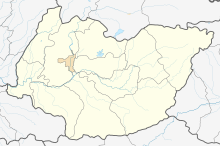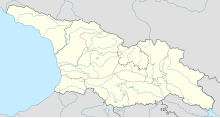
Imereti is a region of Georgia situated in the central-western part of the republic along the middle and upper reaches of the Rioni River. Imereti is the most populous region in Georgia. It consists of 11 municipalities and the city of Kutaisi, which is the capital of the region.

Potash includes various mined and manufactured salts that contain potassium in water-soluble form. The name derives from pot ash, plant ashes or wood ash soaked in water in a pot, the primary means of manufacturing potash before the Industrial Era. The word potassium is derived from potash.

Iron ores are rocks and minerals from which metallic iron can be economically extracted. The ores are usually rich in iron oxides and vary in color from dark grey, bright yellow, or deep purple to rusty red. The iron is usually found in the form of magnetite (Fe
3O
4, 72.4% Fe), hematite (Fe
2O
3, 69.9% Fe), goethite (FeO(OH), 62.9% Fe), limonite (FeO(OH)·n(H2O), 55% Fe) or siderite (FeCO3, 48.2% Fe).
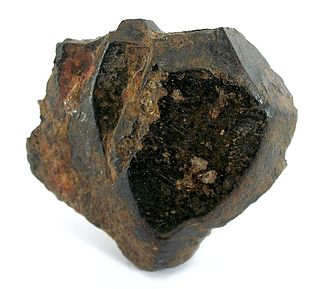
Ilmenite is a titanium-iron oxide mineral with the idealized formula FeTiO
3. It is a weakly magnetic black or steel-gray solid. Ilmenite is the most important ore of titanium and the main source of titanium dioxide, which is used in paints, printing inks, fabrics, plastics, paper, sunscreen, food and cosmetics.

Chiatura is a city in the Imereti region of Western Georgia. In 1989, it had a population of about 30,000. The city is known for its system of cable cars connecting the city's center to the mining settlements on the surrounding hills. The city is located inland, in a mountain valley on the banks of the Qvirila River.

Zestafoni or Zestaponi is the administrative center of Zestafoni District in Western Georgia. Zestafoni is the center of an ancient, historical part of Georgia – Margveti, which is a part of Imereti province. Zestafoni is the center of Margveti's Eparchy of the Georgian Orthodox Church. Zestafoni is situated in the furthest east of the Colchis Plateau, and is built on both banks of the Qvirila River.
Ferroalloy refers to various alloys of iron with a high proportion of one or more other elements such as manganese (Mn), aluminium (Al), or silicon (Si). They are used in the production of steels and alloys. The alloys impart distinctive qualities to steel and cast iron or serve important functions during production and are, therefore, closely associated with the iron and steel industry, the leading consumer of ferroalloys. The leading producers of ferroalloys in 2014 were China, South Africa, India, Russia and Kazakhstan, which accounted for 84% of the world production. World production of ferroalloys was estimated as 52.8 million tonnes in 2015.

Vale S.A., formerly Companhia Vale do Rio Doce is a Brazilian multinational corporation engaged in metals and mining and one of the largest logistics operators in Brazil. Vale is the largest producer of iron ore and nickel in the world. It also produces manganese, ferroalloys, copper, bauxite, potash, kaolin, and cobalt, currently operating nine hydroelectricity plants, and a large network of railroads, ships, and ports used to transport its products.

Lake Valley was a silver-mining town in Sierra County, U.S. state of New Mexico.
Konongo is a gold bar mining and manganese mining community located in Ashanti, Ghana. The town serves as the capital of the Asante Akim Central Municipal. As of 2012, Konongo has a settlement population of 41,238 people. Konongo is about 53 kilometres (33 mi) from Kumasi, the Ashanti capital.
Mining has been conducted in Georgia for centuries. Today, Georgia's mineral industry produces manganese, copper and various types of quarried stone. Although the Georgian economy has experienced significant economic growth in recent years, growth in the mining and metallurgical sector has lagged behind that of the overall economy.

Zestafoni is a municipality of Georgia, in the region of Imereti. The municipality covers a total area of 423 square kilometres and as of 2014 it had a population total of 57,628 people. Its main town is Zestafoni which is an important industrial center, with a large ferro-alloy plant processing manganese ore from nearby Chiatura. The municipality is a notable wine-growing region.
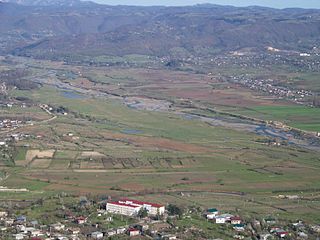
The Qvirila is a river of Georgia. It is 140 km (87 mi) long, and has a drainage basin of 3,630 km2 (1,400 sq mi). It is a left affluent of the Rioni, which it joins south of the city Kutaisi.

Metal production, in particular iron and steel industry, is the dominant heavy industry in Ukraine. Ukraine is the world's eighth largest producer and third largest exporter of iron and steel (2007). Ukrainian iron and steel industry accounts for around 2% of worldwide crude steel output, 5% to 6% of the national gross domestic product and 34% of Ukrainian export revenue. In 2007 it employed 420,000 people – 10% of industrial labor and 2% of the total workforce. It has the highest, by a wide margin, revealed comparative advantage of all branches of the Ukrainian economy. The industry peaked at 42.8 million tonnes in 2007 but has been gravely affected by the financial crisis of 2007–2010 and declined to 29.8 million tonnes in 2009.
The Wafangzi mine is a mine located in the north of China in Inner Mongolia. Wafangzi represents one of the largest manganese reserve in China having estimated reserves of 37.7 million tonnes of manganese ore grading 24% manganese metal.

The N'chwaning mine are located in the Northern Cape Province of South Africa. N'chwaning has one of the largest manganese reserves in South Africa having estimated reserves of 323.2 million tonnes of manganese ore grading 42.5% manganese. There are three shafts, designated as N'Chwaning, N'Chwaning II and N'Chwaning III. The majority of the major mineral finds documented originate from the N'Chwaning II shaft.

Zinc mining in the United States produced 780,000 tonnes of zinc in 2019, making it the world's fourth-largest zinc producer, after China, Australia, and Peru. Most US zinc came from the Red Dog mine in Alaska. The industry employed about 2,500 in mining and milling, and 250 in smelting.
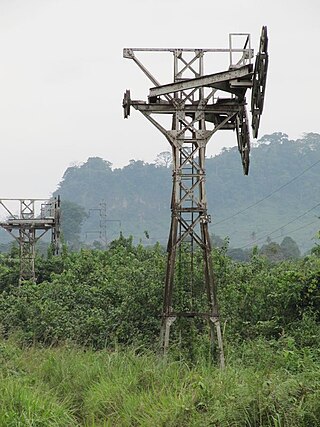
The Compagnie minière de l'Ogooué, or COMILOG, is a manganese mining and processing company based in Moanda, Gabon. It is a subsidiary of the French metallurgical group Eramet. The company is the world's second largest producer of manganese ore. At first the ore was carried by a cableway to the border with the Republic of the Congo, then by rail to the sea at Pointe-Noire. In the 1980s a railway was built to carry the ore through Gabon to the sea near Libreville.
The Beta Hunt Mine is a nickel and gold mine near Kambalda in Western Australia. It is owned and operated by Canadian company Karora Resources through a subsidiary named Salt Lake Mining Pty Ltd. The mining tenement is held by Gold Fields Limited and leased to Salt Lake Mining.
The metallurgical production of the Republic of Azerbaijan is considered high due to the large deposits of alunite, polymetallic ores, deposits of iron ore, etc. The metallurgy industry of Azerbaijan encompasses both ferrous and non-ferrous branches.

